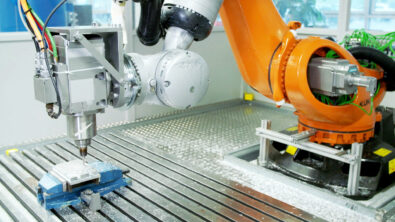Talking Aerospace Today – The Need for a Digitalized A&D Industry – Transcript

The Talking Aerospace Today podcast returns with Todd Tuthill and Patty Russo discussing how A&D companies can mature their digital transformations. This first episode explores the current state of the industry and why digital transformation is needed to address its challenges.
Listen to the original episode or continue reading for the full transcript.
Patty Russo: Welcome to another episode of Talking Aerospace. Today, it’s been a little bit since our last podcast. Both Todd and I had been settling into our new roles, but now that it’s been a year since we both joined the team, we aim to have a more regular cadence for these podcasts. So thank you for joining us and we look forward to talking to you a little more regularly. Todd Tuttle is our A&D Industry VP here at Siemens Digital Industries software. Recently, he’s talked in articles and some other podcasts about how companies need to increase their digital transformation maturity.
Patty Russo: It’s been a while since our last podcast and before we get into the digital transformation topic, Todd, can you give us an update on the state of the industry, the aerospace and defense industry?
Todd Tuthill: Absolutely. And Patty, thank you. It’s great to be back in the saddle and the podcast again, and talking about aerospace. As you know it is my favorite thing to talk about and this is such an incredible time in the aerospace industry. You know, when people talk to me about the future of the industry, the state of the industry, I have two words. The first word is growth. and the second word is innovation. And when I think about growth, it’s just unprecedented in my career, and I’ll date itself here and say I’ve been in aerospace more than 30 years, but something’s happening right now that has never happened in my whole history.
Todd Tuthill: Typically in aerospace, there are cycles that kind of wax and wane. Commercial spending, commercial development will be up and defense spending and development will be down and then it will switch. And it kind of goes back and forth. And I’ve seen those waves throughout my career and that’s just normal in the industry, things we expect. But right now, for the first time in more than 30 years, the outlook for commercial aerospace is up significantly over the next five years. The outlook for spending for defense side is up, and there’s this big, pardon the pun, explosion in space as well. Everything is up.
Todd Tuthill: There’s just incredible growth and to go along with that, there’s also incredible innovation. We’re going to go back to the Moon soon and that’s going to launch our ability to go to the Mars. It’s incredible to think that in our lifetimes, human beings may be on Mars, and that’s just incredible for me to think about. All kinds of other things going on. Space tourism is going to become a thing. It’s already been kind of space tourism for what I’ll say the ultrarich, but over the next 5 to 10 years, that’s going to be democratized. And just everyday people, you know, will say, “Well, do you want to go- what do you want to do this weekend?”
Todd Tuthill: “Well, let’s just go up to space for a few hours.” Right? That’s going to become more and more commonplace as well. As you know, we’re going to realize George Jetson’s dream, and we’re going to have flying cars. I’m going to predict that by the end of this decade when you open your Uber app, one of the options is going to be Uber air, and you’re going to have the option in large cities to take a flying car, an urban air mobility via aircraft is what it’s called. You be able to fly place to place within cities, in electric cars.
Todd Tuthill: And you know in the commercial side we talk a lot about sustainability. There’s incredible innovations going on with sustainability relative to hydrogen and other electric aircraft, and then on the defense side, we’re looking at 6 Gen fighters. There’s going to be a couple of 6 Gen fighters developed in the United States, and there’s another one being developed in Europe. Just incredible times. Incredible innovation in the aerospace industry.
Patty Russo: No doubt it is super exciting and it’s a great time to be in this industry and I have to digress for a moment.
Todd Tuthill: Yep.
Patty Russo: In terms of the George Jetson and the flying cars and the urban air mobility, it’s already on the ground. I got a FaceTime last evening from my son, who is in Phoenix, who was in the back of a driverless Uber. So it’s here.
Todd Tuthill: Right.
Patty Russo: And it will be in the air soon.
Todd Tuthill: That’s right.
Patty Russo: So that said, but with all the growth, let’s talk about that. You talked about growth and innovation. With all of the growth, we know that that’s obviously great for our industry, great for our customers. However, there are potentially some obstacles related to this boom and this growth. So what are some of those obstacles that our customers might face as they aim to achieve all of this innovation and manage this growth?
Todd Tuthill: Yeah, Patty, when I talk to a customers, OEMs, first tier suppliers of second tier suppliers, there’s two themes I hear over and over again. And those themes are supply chain and workforce. Supply chain and workforce. Of course we know with the COVID pandemic that caused, wreaked havoc, you know, in supply chain. You know, there was almost, I guess it was the Christmas of 2020 almost didn’t happen because of all the ships stuck out in the on the ports in the Pacific. You know, and that didn’t just happen in, you know, the toys we were going to buy for Christmas. It happened in the supply chain for everything we build, from automobiles to aircraft to electronics, and we’re still feeling that in aerospace right now in terms of supply chain and getting the parts.
Todd Tuthill: And there are a number of aerospace companies that are struggling to meet their deliverables because of that. And then, of course, on the defense side, as you know there, there’s tensions. There’s things going on in Europe with the war in Ukraine, which is caused a depletion in a lot of the stockpiles of a lot of things and a lot of our defense customers are struggling to find all the parts to build everything where we’re replacing for the defense of Ukraine.
Todd Tuthill: But the core of the supply chain issues and I’ll say even the core of larger issues facing the defense industry or the, excuse me, the aerospace industry right now, the core of that is really workforce challenges. And you hear it over and over again. “Where are we going to find all the engineers to design these incredible innovative products? And where are we going to find all the skilled workers to build and test and deliver them? And the numbers that I’ve seen from analysts say that right now one in ten engineering jobs and industry goes unfilled one in ten.
Todd Tuthill: I was listening to a podcast recently from AVWeek. The CEO of Boeing Defense, Ted Colbert, quoted a couple of interesting numbers. He said that Boeing had hired 10,000 people last year and they planned to hire 15,000 this year. That’s just one number from one large aerospace company. When I look at the job postings on sites, I would estimate that the other large OEMs in the US and abroad in Europe are going to do similar kinds of hiring this year. It’s kind of everywhere and in that one in ten number I quoted you earlier right now, the numbers I see say that by 2030 one in five, one in five, 20% of all engineering jobs will be unfilled. You know, it’s just it seems to be an unsustainable problem we’re up against. We have all this investment, all this innovation, but we’re not going to- we can’t find the people to do all the work.
Patty Russo: So you anticipated my next question, Todd, and that was what needs to change and what you just discussed is the idea that uh, workforce, we need a deeper bench so to speak. More engineers. But there’s also issues related even if we get those engineers on board and working, the impact of their work and the impact of current engineers could potentially be maximized. How can we do that? What’s the next step or what are the ways that companies might consider overcoming the obstacle of, you know, their current engineers, and then once they bring others on board, multiplying their impact?
Todd Tuthill: Yeah. There’s several steps that I think we need to take. You know, we obviously we want to look at better education. You know, when I’m out talking to people and talking to young people who are students, who are in high school thinking about careers, I’m talking about engineering. I’m talking about aerospace. We need to train more engineers. We absolutely do. And colleges are trying to do that, and that’s one aspect.
Todd Tuthill: Another aspect that we saw in COVID there was the Great Resignation. There was this whole idea, especially that, “Well, I can work from home.” And there are a lot of industries where work from home works, right? If you’re writing software, if you’re doing- if you’re processing information, a lot of that work can be done from home. But when we’re talking about aerospace, we’re building real physical products being that are being delivered and a lot of those jobs tend to be on site. That’s especially true if what we’re doing on the defense side is classified. So that’s caused a number of engineers to want to leave the aerospace industry.
Todd Tuthill: So we need to do things to make aerospace engineering more attractive and more interesting. We need to talk about how great and awesome it is to be in the aerospace industry and to create things that fly, to be a part of all this innovation. And all those things will help, but all those things together won’t fix the problem. It goes back to something you said in your question. You talked about multiplying the impact of engineers. And I think the next real significant step that we need to grapple with as an industry is talking about how to do that. And I really believe that digital transformation is the gateway, is the significant piece of taking the engineers we have today and the engineers that will have in the industry over the next couple of decades to do all this innovative work and really multiplying the impact of those engineers helping them do a lot more than they’re able to do themselves. Yeah, it’s digital transformation. I really see that as the key to helping us get over this workforce problem.
Patty Russo: So if that’s the key, then that’s the “what needs to solve- what’s needed to change, to solve the challenge.” Here comes the question of the how? How does digital transformation help solve this problem? How does that connect to the multiplying of the workforce?
Todd Tuthill: OK, so as you know, I’ve been in the industry for many years, in the aerospace industry. I was a director of engineering, associate director at several companies and I had a lot of staff working for me and, you know, one of the things I liked to do was to really understand how are my staff working and how did they spend their time every day? You know, I’d go talk to them. I’d talk to their managers. I watched them work sometimes. And it was shocking to me, Patty, how much time that- because these very talented, very intelligent, several of them with PHDs, engineers. They went to school to study all this physics in all this math and the amount of time they spend in their day looking for information, copying information, moving things back and forth, doing a bunch of mundane things.
Todd Tuthill: And there’s lots of reasons for that. You know, we talk about the complexity of all these products and some of the teams that are building a large commercial aircraft or a rocket that’s going to fly to Mars, we’re talking about teams of hundreds of thousands of people. So managing information, processing information, connecting information is a very big deal, and we need, you know, very structured processes and very mature tools to do that. And we’ve been working on digital transformation in the industry for a while, but it’s time to take the next step and not just connect the information, but really start to automate it and kind of find ways to do a lot of things that computers are better at humans and leave the human beings to do the higher-level things.
Patty Russo: So it sounds like there’s some great opportunities related to digital transformation and data and connectivity. Is there more than that, though, that customers need to think about as they work to solve the workforce problem?
Todd Tuthill: Absolutely. Those pieces about connecting data are just the beginning. And as a matter of fact, I talked to customers and one of the things they asked me in the process of digital transformation is exactly that they’ll say, you know, “Where is the return on investment? What am I going to get if I partner with a digital transformation company, technology company like Siemens? What’s my ROI? When do I get my money back?” And I like to say, well, certainly you can- that piece of it, that connection of data, that’s very valuable. But there’s so much more, and it begins then with not just knowing where your data is at and connecting your data, but really making your data work for you.
Todd Tuthill: And we talk about the digital twin and really working through and doing things virtually and learning virtually before you have to build physically, right. And we talk about the concept of digital threads and the ability to not just connect data in the beginning, but use that data all the way through the design process to use it in design and then transfer that all the way forward to manufacturing and through the, you know, the idea of a comprehensive digital twin in the idea of a digital twin in the design and a digital twin in the manufacturing and combining those into one continuous process. So there’s a lot more to do than just connect data to return that ROI.
Patty Russo: That’s super exciting, especially in light of the fact that our solutions help customers connect the virtual with the real to do some of that work virtually so that when they are producing physical products, they’ve streamlined that process and saved time and resources and money getting from point A to point B. So how are companies, how are you seeing some of our customers and companies in the A&D industry, how are they leveraging digital transformation right now? Have you seen progress that any customers are making? Obviously, we probably don’t want to name names, but I’m guessing you’ve talked to some folks out there that have some great insights on this.
Todd Tuthill: Yes. We were fortunate to partner with a consulting company called CIMdata that did a big research study and reproduced a report earlier this year on digital threads, digital transformation, state of the industry, and what we saw was some really positive things. Companies see a lot of value in digital threads. Companies are really investing in digital threads, with a real emphasis right now on the connection part on bringing all their data together, connecting it so that they can do a lot of work with it. And I think they’re really, a lot of companies are really ready when they’re looking at the full ROI and the things I talked about before, they’re really ready to realize and take the next steps.
Patty Russo: So it’s really great to hear that companies are ready to take digital transformation further. We could dive even deeper, Todd, but I think we’re out of time for today. I do look forward to continuing the conversation, though, and talking more about this in our next episode. So thank you, Todd, and thank you to our listeners for joining us for this episode of Talking Aerospace Today. I’m Patty Russo, and we’ll see you next time.
Siemens Digital Industries Software helps organizations of all sizes digitally transform using software, hardware and services from the Siemens Xcelerator business platform. Siemens’ software and the comprehensive digital twin enable companies to optimize their design, engineering and manufacturing processes to turn today’s ideas into the sustainable products of the future. From chips to entire systems, from product to process, across all industries. Siemens Digital Industries Software – Accelerating transformation.


